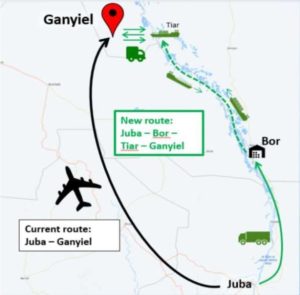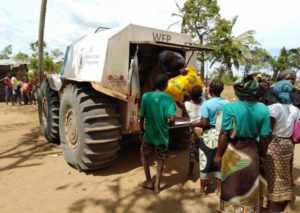Scope of application
The goal of A.H.E.A.D. is to develop fundamentals and technologically intelligent solutions for remote control of vehicles in unstructured environments. The technology developments in the field of environmental perception, localization, semantic recognition, as well as teleoperation are led to a high degree of technological maturity in validation tests and demonstrators. It is expected that scientific publications on the work will also take place.
This project is intended to pave the way for the additional support and development of humanitarian aid and, at WFP’s request, teleoperate deliveries of food that would pose a threat to human drivers. In addition to humanitarian aid deliveries of food, the field of application of the last mile is currently of high technical and economic relevance for many other transport tasks and markets. Within the framework of this project, technologies are being developed that enable AI-based (partially) autonomous navigation of systems. The developed technology can also be taken for the use of semi-autonomous/teleoperated mobile robots in delivery scenarios. The environment is also very dynamic and unstructured in these applications due to sidewalks, footpaths, courtyards or staircases, which is why technologies from the automotive and industrial automation sectors are only used to a limited extent. In particular, the areas of environmental perception, localization and semantic annotation are of essential importance for the successful use of robots for delivery services.
DLR Technology Marketing and various partners form an innovative network here and support spin-offs and technology exploitation. The WFP Business Accelerator has established its location in Germany exactly in Munich in order to introduce technologies and new companies into the WFP’s field of need with pilot projects and to generate possible service providers.
Usecase South Sudan
A direct reuse of the demonstrator by the associated partner WFP is planned. At the WFP, a worldwide growing demand for aid deliveries is to be expected. In the report “GLOBAL REPORT ON FOOD CRISES 2020”, the WFP speaks of a threatening increase in the world’s starving population from 2018 to 2019 by 22 million people, about 16% of the world’s population. Aid workers from humanitarian organizations are exposed to an increasing variety of dangers and threats. Numerous missions take place in high-risk environments, e.B. in fragile states with conflicting parties. Despite treaties aimed at banning the use of landmines and despite continuous demining initiatives, deadly incidents involving mines or improvised explosive devices are ubiquitous. Drivers of humanitarian trucks are exposed to these risks on a daily basis.
In addition to the man-made dangers, there are many natural risks in the respective areas of application, e.B. snakes and insects, which transmit diseases such as e.B. malaria. Other health risks for drivers include epidemics, e.B. outbreaks of the Ebola virus (Sierra Leone, DRC) or the COVID-19 pandemic (worldwide).
Especially in areas that are rarely frequented by people, these risks are difficult to estimate in advance. Many of the humanitarian aid sites are difficult to reach because there is usually insufficient infrastructure in the affected areas or, in the event of a disaster scenario, is no longer intact. Here, the teleoperated vehicles can be used to make the operation safer and save lives.
In addition, economic and ecological aspects of the transport of aid deliveries must be considered. Deliveries by plane are very costly and also have an ecological impact on the region. Therefore, where possible, they are replaced by local, alternative supply chains. In the use case of South Sudan, the WFP already delivered 800 mt (metric tons) within 5 weeks in February 2019 in a test with 18 sherps and was thus able to replace 25 “airdrops”
These aid deliveries can be done most of the route with boats and vehicles. However, the “last mile”, a distance of up to 50 km, leads through partly flooded areas, which expose drivers to great risks.
In A.H.E.A.D we are developing a concept for robot-controlled, remote-controlled vehicles in which the delivery of the “last mile” can be carried out by telepresence from a safe location, e.B. in Tiar, in the very impassable environment of Sudan.



